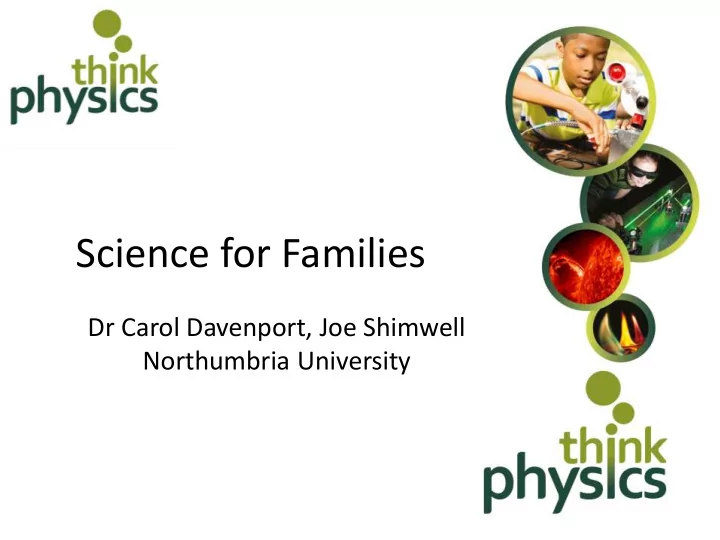

Science for Families Dr Carol Davenport, Joe Shimwell Northumbria University
Outline • Why Science for Families? • Science for Families outline • Practical activities • What can you do back in school?
Why Science for Families? • Parental engagement is key in young children’s success in school. • Many schools and local authorities run ‘Keeping up with the kids’ courses for parents. • Low socioeconomic status families are often a key focus. • But, rarely offer anything in science.
Developed by Think Physics and delivered in conjunction with North Tyneside Family Learning. Think Physics worked with the tutors to train them on how to run the course. The tutors then delivered the course (or sessions) in different venues in North Tyneside.
The aims of Science for Families • Introduce families to simple activities in science • Children and adults work together to complete the activities • Highlight that asking questions is a key skill in science • Increase the science capital of the family by providing opportunities to talk about science at home.
Think Physics: Science for Families A session outline 1. Talking about science 2. Three activities 3. Do It At Home Get in touch E: think.physics@northumbria.ac.uk W: thinkphysics.org T: @thinkphysicsne
Think Physics: Science for Families Talking about science How do we talk about science? Find out what you already know. Talk and listen. “I don’t know.” = “Let’s find out!” Get in touch E: think.physics@northumbria.ac.uk W: thinkphysics.org T: @thinkphysicsne
Think Physics: Science for Families An activity sheet Simple explanation of how to compete the activity supported by a demonstrations led by the session leader. A list of ‘BIG Questions’ to discuss as a family Get in touch E: think.physics@northumbria.ac.uk W: thinkphysics.org T: @thinkphysicsne
Think Physics: Science for Families The ‘Do it at home’ Each session ends with a ‘Do It At Home’ experiment to extend the learning past the classroom. Get in touch E: think.physics@northumbria.ac.uk W: thinkphysics.org T: @thinkphysicsne
Think Physics: Science for Families Session 1: Seasons, Earth & Space, Light Activity 1.1: A Cloud in a Bottle Activity 1.2: A Spectroscope Activity 1.3: A Planisphere Activity 1.4: A Lunar Diary Get in touch E: think.physics@northumbria.ac.uk W: thinkphysics.org T: @thinkphysicsne
Think Physics: Science for Families Session 2: Plants and Animals Activity 2.1: Investigating Fingerprints Activity 2.2: Plant Dissection Activity 2.3: Growing Seeds Get in touch E: think.physics@northumbria.ac.uk W: thinkphysics.org T: @thinkphysicsne
Think Physics: Science for Families Session 3: Living things and their habitats Activity 3.1: A Homemade Pooter Activity 3.2: Shaking Trees (i) Activity 3.3: Shaking Trees (ii) Get in touch E: think.physics@northumbria.ac.uk W: thinkphysics.org T: @thinkphysicsne
Think Physics: Science for Families Session 4: Changing Materials Activity 4.1: Yeast Balloons Activity 4.2: Chromatography Activity 4.3: Oobleck Activity 4.4: Investigating Bubbles Get in touch E: think.physics@northumbria.ac.uk W: thinkphysics.org T: @thinkphysicsne
Think Physics: Science for Families Session 5: Forces, Sound and Electricity Activity 5.1: Talking Tin Cans Activity 5.2: Cartesian Divers Activity 5.3: Lemon Batteries Activity 5.4: A Bottle Fountain Get in touch E: think.physics@northumbria.ac.uk W: thinkphysics.org T: @thinkphysicsne
Activities 1. A spectroscope 2. Fingerprints 3. Growing seeds
Activity 1.1 The Visible Spectrum
Activity 1.1 The Visible Spectrum The white light we see is actually made up of a spectrum of colours (the visible spectrum). We recognise these colours as a rainbow. When you look at different light sources with the spectroscope you will see different patterns of colours. Different elements have different patterns of colours. The partners of colours are like a fingerprint. Astronomers look at the light from stars and use the fingerprints to work out what the stars are made from.
Activity 2.1 Fingerprints
Activity 2.1 Fingerprints Fingerprints are caused by friction ridges on the skin of the hands and feet. Every human has a unique set of fingerprints. Fingerprinting is therefore useful for forensic scientists who work with the police to identify suspects of crime. They dust for fingerprints at the scene of a crime and compare prints to a database. Some animals also have fingerprints; a koala’s fingerprints are very similar to a humans!
Activity 2.3 Growing Seeds
Activity 2.3 Growing Seeds Science at home Once you get your seeds home, fill the bag to a height of 2cm with water. Then fix it to your fridge or noticeboard. Over the next few days, your seeds will germinate and you can watch as they grow into plants. When they are too big for the bag, you can plant them outside or in a plant pot to watch them grow further.
What can you do back in school?
Get in touch thinkphysics.org/ase2016 think.physics@northumbria.ac.uk @ThinkPhysicsNE @DrDav Think Physics Partners
Recommend
More recommend